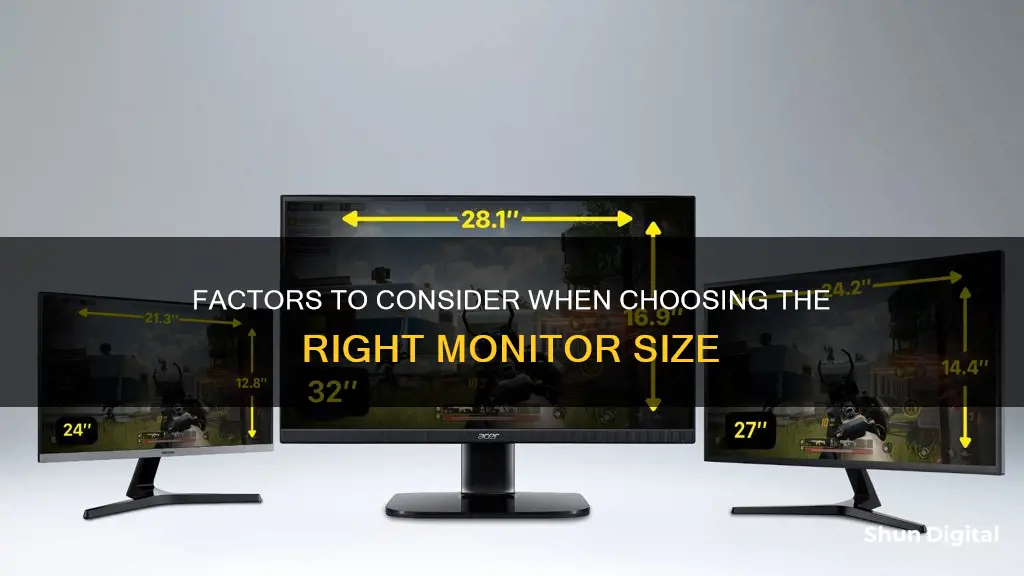
Choosing the right monitor size depends on several factors, including intended use, available space, and personal preference. For example, gamers often prefer larger monitors to enhance their gaming experience, while those with limited desk space may opt for a smaller monitor. Additionally, the resolution and aspect ratio of the monitor also play a crucial role in determining the ideal size.
| Characteristics | Values |
|---|---|
| Ideal for gaming | 24-25 inches, 27 inches, 32 inches, 34 inches, 49 inches |
| Ideal for working from home | 27 inches, 24 inches, 32 inches |
| Ideal for video editing or other creative roles | Larger screen size |
| Ideal for general use | 27 inches, 24 inches |
| Ideal for gaming and content consumption | 27 inches, 32 inches |
| Ideal for competitive gaming | 24-25 inches |
| Ideal for immersive gaming | 34 inches, 49 inches |
What You'll Learn

24-inch monitors: ideal for small desks
24-inch monitors are ideal for small desks. They are a good choice if you have limited desk space or if you find larger screens too big. They are also a great companion to a laptop, offering a larger, space-efficient second screen that can charge your device while you work.
A 24-inch monitor is also perfect for those who want a second screen for their laptop that won't take over their desk, or for desktop owners who want a dual-screen setup while saving space and money.
While 24-inch monitors are not as popular as larger monitors, and companies are not producing as many models as before, they are still useful for some people. They are also a good choice if you have a small, slim desk (say, around 24 inches deep or less) or otherwise bring the monitor closer to your face. A 24-inch monitor may sound small, but it'll look reasonably large because it's so close.
You can buy a decent all-around 24-inch monitor like the HP 24mh for less than $200. It won't wow you, but it works in a pinch.
If you're looking for a less expensive 24-inch monitor, the Asus VA24DCP is typically priced around $170. It also has a USB-C connection that can charge most laptops, but it lacks features such as a fully adjustable stand, and it doesn’t have a USB hub or the ProArt PA248CRV’s great colour accuracy.
If you're looking for a monitor with better colour accuracy, the Asus ProArt PA248CRV is an especially good monitor for most people because it has a larger 16:10 display, USB-C charging, a USB hub for peripherals, and fantastic colour accuracy.
Setting Up Audio on Your ASUS XG35VQ Monitor
You may want to see also

27-inch monitors: a good balance of size and resolution
When it comes to choosing a monitor, there are several factors to consider, including size, resolution, connectivity, ergonomics, and panel type. While the "ideal" monitor may vary depending on individual preferences and intended use, here's why 27-inch monitors are a good balance of size and resolution for many users:
Size
The size of a monitor is an important factor to consider, as it determines how comfortable it is to use and how much desk space it requires. While bigger monitors may look more impressive, they can be uncomfortable when placed close to the user's eyes. A 27-inch monitor strikes a good balance by offering a large enough screen size without being excessive. It is large enough to look impressive on a typical home office desk but isn't too big, making it suitable for most users. Additionally, a 27-inch monitor provides enough screen real estate to place two windows side-by-side, which can be useful for multitasking.
Resolution
Resolution refers to the number of pixels on a monitor and plays a crucial role in determining the sharpness and clarity of the display. A higher resolution means more pixels, resulting in a sharper and crisper image. When it comes to 27-inch monitors, the WQHD (2560x1440) resolution, also known as QHD or 1440p, is often considered ideal. This resolution provides a good balance between picture clarity, detail, and screen size. At this resolution, you can expect a pixel density of around 108 pixels per inch (PPI), which offers a good balance between image quality and performance.
While 4K resolution (3840x2160) is also an option for 27-inch monitors, it may not be necessary for everyone. 4K provides a sharper image with more pixels, but it also requires more powerful hardware to run and can be more expensive. For those who don't need the highest level of detail, QHD on a 27-inch monitor is a sweet spot that offers a balance between image quality and performance.
Connectivity
When it comes to connectivity, most 27-inch monitors offer a variety of options, including HDMI, DisplayPort, and USB-C. USB-C is particularly useful as it allows for a single-cable connection to modern laptops, enabling both video transmission and charging through the same port. Additionally, some 27-inch monitors act as a USB hub, providing additional USB-A and USB-C ports for connecting peripherals.
Ergonomics
Ergonomics is another important consideration when choosing a monitor. A good monitor should have a stand that allows for height adjustment, tilt, and swivel to ensure a comfortable viewing experience. Many 27-inch monitors also support VESA mounting, allowing users to attach the monitor to a monitor arm for added flexibility in positioning the display.
Panel Type
The panel type of a monitor refers to the technology used in the display. IPS (In-Plane Switching) panels are commonly found in 27-inch monitors and offer accurate colors and wide viewing angles. While IPS panels may struggle with dark scenes and exhibit "IPS glow", they are still a good choice for most users, including gamers, due to their overall image quality and performance.
In conclusion, 27-inch monitors offer a good balance of size and resolution, making them a versatile option for a range of users. They provide a large enough screen for comfortable viewing and multitasking without being overly cumbersome or requiring excessive desk space. The WQHD resolution strikes a balance between image quality and performance, and modern connectivity options ensure compatibility with various devices. Additionally, the availability of ergonomic features and IPS panels makes 27-inch monitors a good choice for those seeking a comfortable and visually appealing viewing experience.
Resetting Your ASUS VG245 Monitor: A Step-by-Step Guide
You may want to see also

32-inch monitors: for high-end gaming
32-inch monitors are ideal for high-end gaming, offering more screen space for an immersive gaming experience. While 27-inch monitors are more common, 32-inch monitors are growing in popularity and usually have a 4K or 1440p resolution. Premium models tend to have HDMI 2.1 bandwidth, allowing you to take full advantage of modern graphics cards or gaming consoles.
When choosing a 32-inch monitor for high-end gaming, consider the following:
- Response Time and Input Lag: For a responsive gaming experience, look for a monitor with a fast response time and low input lag. While most monitors have low input lag, a fast response time will ensure sharp motion and reduce motion blur.
- Resolution: Aim for a 4K resolution (3840 x 2160) or a 1440p resolution (2560 x 1440). 4K resolution provides a rich pixel density and crystal-clear visuals, but keep in mind that you'll need a powerful graphics card to handle it. 1440p is a good middle ground, offering a crisp image without requiring as much processing power.
- Refresh Rate: A higher refresh rate means smoother and more fluid motion. While 60Hz is standard, consider opting for a higher refresh rate like 144Hz or 240Hz for an even better gaming experience. However, keep in mind that to take full advantage of a high refresh rate, you'll need a top-of-the-line graphics card.
- Panel Type: The two main types of panels used in 32-inch gaming monitors are IPS (In-Plane Switching) and VA (Vertical Alignment). IPS panels offer accurate and consistent colors, wide viewing angles, and high refresh rates. On the other hand, VA panels provide deeper blacks and better contrast, making them ideal for games with dark scenes. Choose the panel type that best suits your preferences and the type of games you play.
- Additional Features: Look for monitors with gaming-specific features like AMD FreeSync or NVIDIA G-SYNC for smooth gameplay, low blue light modes to reduce eye strain, and built-in speakers or headphone jacks for audio.
- Samsung Odyssey G7 LC32G75TQSNXZA: This monitor offers a high 240Hz refresh rate, stunning visuals, and an aggressively curved screen for an immersive gaming experience. It has a 1440p resolution, AMD FreeSync Premium Pro support, and excellent image quality with a wide color gamut and good color accuracy.
- Alienware AW3225QF: The Alienware AW3225QF is the first 32-inch 4K 240Hz QD-OLED gaming monitor on the market. It offers exceptional color accuracy, vivid visuals, and a range of connectivity options. It also includes quality-of-life features like ample USB ports.
- MSI MPG 321URX: This monitor features a 4K resolution, a 240Hz refresh rate, and a QD-OLED panel, delivering stunning visuals and smooth performance. It has good connectivity options and is one of the most affordable options in its class.
- LG 32GQ850: The LG 32GQ850 is a flat-screen 32-inch gaming monitor with a 240Hz refresh rate and a DisplayHDR 600 certification. It has a wide 98% DCI-P3 color gamut, accurate colors, and a rapid pixel response time for minimal ghosting. It supports AMD FreeSync Premium and NVIDIA G-SYNC Compatible technologies for smooth gameplay.
- Samsung Odyssey Neo G7 S32BG75: With a 4K resolution and a 240Hz refresh rate, this monitor delivers exceptional performance. It features a Mini LED backlight, deep blacks, and excellent motion handling. It also includes useful features like Tizen OS, allowing you to stream movies and shows without needing a PC.
Monitoring GPU Performance: FPS, Temps, and Usage During Gameplay
You may want to see also

Ultrawide monitors: wider field of view for gaming
Ultrawide monitors are great for gaming, especially for immersive gaming experiences. They have a 21:9 aspect ratio, with a 34-inch screen, and some have larger 49-inch super ultrawide displays with a 32:9 aspect ratio. Ultrawide monitors are useful for gaming as they allow you to see more of your surroundings in games than standard 16:9 monitors. They are particularly well-suited for racing games, first-person shooters, and flight simulators, as they provide a panoramic view and a wider field of view.
When choosing an ultrawide monitor for gaming, it is important to consider the following specifications:
- Response time: A response time of 1ms or less is ideal to ensure that your screen can keep up with your fast actions.
- Refresh rate: A refresh rate of at least 100Hz is recommended for gaming with a high frame rate.
- G-Sync or FreeSync support: Depending on whether you have an NVIDIA or AMD graphics card, you will need G-Sync or FreeSync support to prevent screen tearing and stuttering.
- Screen size: A screen size of at least 34 inches is recommended for gaming, so you don't have to sit too close to the screen.
Some popular ultrawide monitors for gaming include:
- Dell Alienware AW3423DWF: This monitor has a 34-inch screen with an 1800R curve, a near-instantaneous response time, and a 165Hz refresh rate. It uses a QD-OLED panel, providing exceptional picture quality with deep blacks and vivid colours.
- LG 34GS95QE-B: This monitor has a 34-inch screen with a more aggressive 800R curve and a higher 240Hz refresh rate. It is a WOLED monitor, so it doesn't appear purple in brighter rooms like the Dell monitor.
- LG 34GP83A-B: This is a more affordable option with a 34-inch screen and a 160Hz refresh rate. It has an LED-backlit IPS panel, so it can't display deep blacks like the OLED monitors, but it offers sharper text, which is ideal for text-heavy games.
- Dell S3422DWG: This is a budget-friendly option with a 34-inch screen and a 144Hz refresh rate. It has good picture quality for HDR gaming, with a higher native contrast ratio and deep blacks that don't look washed out.
When choosing an ultrawide monitor for gaming, it is also important to consider the size of your desk and the distance between you and the monitor. Ultrawide monitors can be quite large, so ensure you have enough space on your desk to accommodate the monitor comfortably. Additionally, consider the distance between you and the monitor, as you may need to adjust your seating position to fully utilise the wider field of view offered by ultrawide monitors.
Monitoring Gas Usage: Individual Apartment Solutions
You may want to see also

Super-ultrawide monitors: an alternative to a multi-monitor setup
Super-ultrawide monitors are an increasingly popular alternative to a multi-monitor setup. They are a good option for those who want to avoid the clutter of a dual-screen setup, and the issues that come with it, such as a thick bezel running down the middle of the display. A single ultrawide monitor is also a plug-and-play experience that requires zero configuration, unlike a dual-monitor setup.
A super-ultrawide monitor, such as the 49-inch Samsung Odyssey G9, can offer a similar amount of screen space to two 27-inch monitors side by side. However, a dual-monitor setup will always offer more flexibility in terms of screen angles and orientation. With two monitors, you can use one in a portrait orientation, adding vertical real estate to your setup. This is perfect for displaying documents or having multiple apps open while working on your primary monitor.
A dual-monitor setup also offers more individual screen real estate for whatever you have open on each screen. For example, you might want to watch a video in fullscreen while working on another screen. A two-monitor setup might also be preferable for gamers who want to play on one screen and view things like YouTube tips or their Discord chat on another.
However, an ultrawide monitor can be more immersive, especially for gaming. A wider aspect ratio means that you can see more at once. For example, in a game like Halo Infinite, an ultrawide monitor makes it easier to track enemies and teammates. The already gorgeous racing action of Forza Horizon 5 also looks even more breathtaking on an ultrawide monitor, as you can take in more of the stunning vistas as you drive. That said, not every PC game supports ultrawide mode, and you'll be playing in standard widescreen if you hook a console up to this type of display.
When it comes to resolution, dual 4K monitors will give you a higher overall pixel density, which is ideal for things like photo editing or single-screen gaming. However, a single ultrawide monitor can still offer a commanding view and is a good alternative to a double or triple monitor setup.
Mounting Your ASUS Monitors: A Step-by-Step Guide
You may want to see also
Frequently asked questions
The ideal monitor size for gaming depends on your preferences and the type of games you play. If you play competitive games, a smaller monitor between 24 and 27 inches is recommended as it allows you to easily see everything within your field of vision. For immersive games, larger monitors in the 32-inch to 49-inch range are popular, with some gamers opting for ultrawide options that provide a wider field of view.
For work or general use, a 27-inch monitor is often considered ideal as it offers a balance between screen size and comfort. It provides ample screen space without being too close to your eyes, making it suitable for extended use. However, if you have limited desk space, a 24-inch monitor may be more suitable.
Screen resolution plays a crucial role in determining the ideal monitor size. A higher resolution means more pixels, resulting in a sharper image. For example, a 27-inch monitor with a 4K resolution will provide a crisp display, while a lower resolution at that size may appear grainy. When choosing a monitor, consider the resolution and ensure it matches the size to avoid a pixelated or blurry image.







